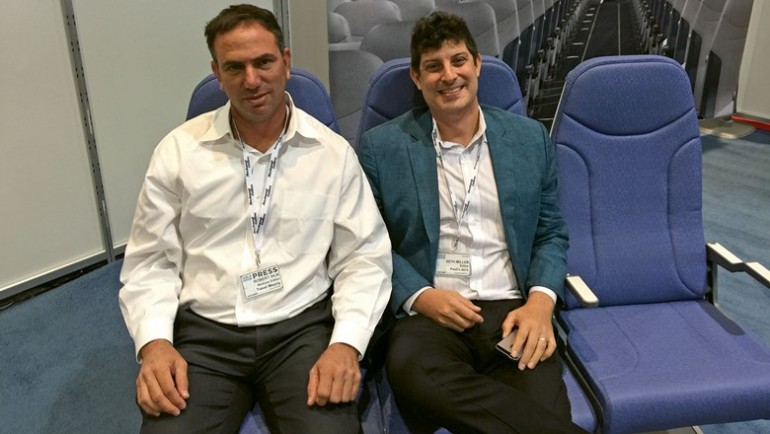Sponsored Listings:
For God’s sake! Enough! She has been trying to ignore it, but if this idiot beside her doesn’t cede a corner of the armrest, she’ll suffocate him with the vomit bag. She makes her elbow as pointy as possible and, very gradually, digs it into his forearm. How long before he gives in? — Tom Rachman, “The Imperfectionists”
LAS VEGAS — Battles over armrest space are the bane of virtually anyone who has ever flown coach on a full flight. But a seat manufacturer that just locked down its first sale aims to alleviate this perpetual source of in-flight aggravation and tension while improving the overall experience of flying in the dreaded middle seat.
Hank Scott, CEO and founder of Molon Labe Seating of Lakewood, Colo., said the company took an order a month ago to furnish seats on 20 Airbus A320s for a Chinese carrier. (Scott didn’t identify the airline because it has not given him permission to do so.)
Molon Labe seats are unique in the industry because of their staggered design. For a row of three-across seats, the middle seat is set in a fixed position slightly behind and lower than aisle and window seats.
Offsetting the seats offers two advantages that Scott emphasizes during sales pitches. The first has to do with the armrest. Because the middle seat passenger is slightly behind and lower than the passengers to the right and left, their natural position to rest arms is different.
Molon Labe’s seats take advantage of this offsetting in the design of their armrests, which have an elevated front half and a lower back half — in essence creating separate spaces for each passenger to rest his or her arms.
I tried out the bifurcated armrest at the Future Travel Experience Global conference in Las Vegas earlier this month, sitting next to fellow aviation reporter Seth Miller of PaxEx.Aero. It wasn’t what I would call spacious. Our arms still grazed slightly.
But since we each had a clearly delineated section of the armrest, there could be no strategizing about staking out space as soon as my neighbor dropped his guard. And there was no (as Rachman describes in his novel) making my elbow “as pointy as possible.”
Without a doubt, in other words, the seat offered an improvement over the slim armrests that have become the norm in economy cabins in recent years.
The second advantage that Scott emphasizes about Molon Labe’s staggered design has to do with spreaders, a component, typically made of aluminum, that connects the seat back to the seat itself. Most aircraft seats have spreaders that are positioned one next to the other, but the Molon Labe seats save space by having vertically stacked spreaders. The result is extra space in the seats themselves.
Standard Molon Labe seats in a typical six-abreast formation for a Boeing 737 are 18.4 inches, or approximately an inch wider than the industry standard. Widths can also be adjusted so that the middle seat is as wide as 19 inches while aisle and window seats have 18 inches of width.
For the seat back, the offset design enables the company to add even more space in the center seat, where its width is 21.7 inches, downright spacious by industry standards. Scott said middle seat passengers effectively get a couple more inches of seatback space than that because their shoulders are behind the passengers on the window and aisle seats.
“What I’m waiting to see,” he said, “is for someone on a plane to ask, ‘Would you like to go to the aisle so I can take the middle seat?'”
Indeed, that would be an impressive feat.
One downside to the staggered design concept is that the seat backs are fixed, meaning passengers can’t recline.
For Molon Labe, the first confirmed sale comes after an arduous 10 years of effort in development and marketing. The company first attempted to enter the market with its slide-slip seat, in which the aisle seat could be slid inward during boarding and exit to create more aisle space.
Speaking on a panel at the Future Travel Experience conference, Scott said he eventually realized that airlines weren’t interested in a product that confuses passengers.
“You have to design for the lowest common denominator,” he said.
The company also faced hurdles breaking into an industry that is resistant to change.
Sitting on the same panel as Scott, American Airlines director of aircraft interiors Brian Richardson explained the dilemma a carrier the size of American faces. It’s difficult, Richardson said, to support innovation while retrofitting hundreds of aircraft, in part because they can’t know if a small supplier can stand behind the order.
“In that type of situation, we don’t want to put in a brand-new seat that people haven’t used before,” Richardson said.
Source: travelweekly.com










